
Temple Newsam, is a Tudor-Jacobean house in Leeds, West Yorkshire, England, with grounds landscaped by Capability Brown. The house is a Grade I listed building, one of nine Leeds Museums and Galleries sites and part of the research group, Yorkshire Country House Partnership.

Normanton is a town in the civil parish of Normanton and Altofts, in the City of Wakefield in West Yorkshire, England. It is north-east of Wakefield and south-west of Castleford. The civil parish extends west and north to the River Calder, and includes the large village of Altofts. At the time of the 2011 Census, the population of the civil parish was 20,872.
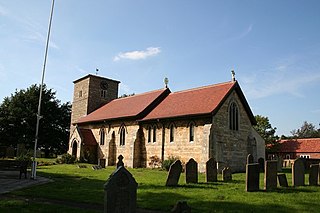
Eagle is a village in the civil parish of Eagle and Swinethorpe, in the North Kesteven district of Lincolnshire, England. It is situated 7 miles (11 km) south-west from Lincoln and 2 miles (3.2 km) east from North Scarle. The population of the civil parish of Eagle and Swinethorpe taken at the 2011 census was 793.
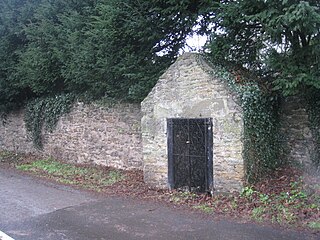
Bottesford Preceptory was sited at Bottesford, just to the south of Scunthorpe, in Lindsey, England. It was on low-lying land, near the Bottesford Beck, about 3 miles (5 km) to the west of the escarpment of the Lincoln Cliff limestone upland, and about the same distance to the east of the River Trent. A preceptory was a community of the Knights Templar who lived on one of that order's estates in the charge of its preceptor. A preceptory also referred to the estate and its buildings. The present Bottesford Manor is believed to have been the gatehouse to the preceptory.

Aslackby Preceptory in Lincolnshire lay to the south-east of Aslackby Church. Until about 1891 a tower, possibly of the preceptory church, together with a vaulted undercroft, survived as part the Temple farmhouse. Temple farmhouse was subsequently rebuilt and a 15th-century window and a stone pinnacle remain in the garden.

Rothley Temple, or more correctly Rothley Preceptory, was a preceptory in the village of Rothley, Leicestershire, England, associated with both the Knights Templar and the Knights Hospitaller.
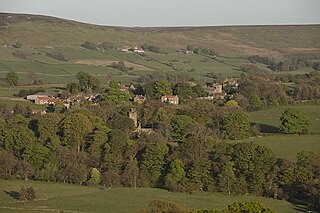
Westerdale is a village, civil parish and dale within the Scarborough district of North Yorkshire, England. The Esk Valley Walk runs through part of the village. The village is at the confluence of three streams (Esklets) which combine as the head of the River Esk.

Temple Normanton is a village and a civil parish in the North East Derbyshire district in Derbyshire, England. The population of the civil parish at the 2011 census was 490.

Altofts is a village in the civil parish of Normanton and Altofts, in the City of Wakefield, West Yorkshire, England. It lies 5 miles (8 km) north-east from the centre of Wakefield and less than 1 mile (1.6 km) north-west of Normanton. The M62 runs close to the village to the north-east, and the Aire and Calder Navigation to the north-west.
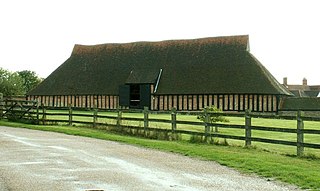
Cressing Temple is a medieval site situated between Witham and Braintree in Essex, close to the villages of Cressing and White Notley. It was amongst the very earliest and largest of the possessions of the Knights Templar in England, and is currently open to the public as a visitor attraction.
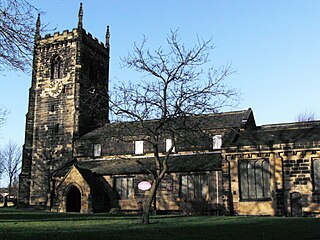
All Saints' Church is the parish church in Normanton, West Yorkshire, England.
Thomas Levett, was an Oxford-educated Lincoln's Inn barrister, judge of the Admiralty for the Northern Counties and High Sheriff of Rutland. But Levett's chief accomplishment was as antiquarian, preserving a centuries-old chartulary kept by Cluniac monks at their Pontefract, Yorkshire abbey, and then turning it over to Yorkshire medieval scholar Roger Dodsworth for publication.

William Levett was lord of the manor of the South Yorkshire village of Hooton Levitt, a village named in part for his ancestors, and became the owner of the patronage of Roche Abbey on marriage to the granddaughter of the Abbey's cofounder Richard FitzTurgis, a Norman baron who co-founded Roche with the great-nephew of one of England's most powerful Norman barons, Roger de Busli.

Yeaveley Preceptory, also known as Stydd Preceptory, was a preceptory of the Knights Hospitaller, near the village of Yeaveley, in Derbyshire, England. It was around a mile west of the village, on the site of the current Stydd Hall. The Preceptory has been variously known as "Yeaveley Preceptory", "Yeaveley Bailiwick", "Yeaveley and Barrow Preceptory" and "Stydd Preceptory".

Ossington Preceptory was a preceptory of the Knights Hospitaller, near to the village of Ossington in Nottinghamshire, England.
Temple Hirst Preceptory was a priory in North Yorkshire, England.
The history of the Knights Templar in England began when the French nobleman Hugues de Payens, founder and Grand Master of the Order, visited the country in 1128 to raise men and money for the Crusades.

Temple Hirst is a village and civil parish in the Selby District of North Yorkshire, England. It was formerly in the wapentake of Barkston Ash in the West Riding of Yorkshire. The village is located on the north bank of the River Aire. In the 2011 census the population was 117.

Temple Guiting is a village and civil parish in the Cotswolds, in Gloucestershire, England. The civil parish includes the smaller settlements of Barton, Farmcote, Ford and Kineton. In 2011 the parish had a population of 463.


















